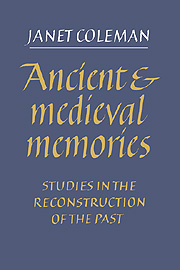Book contents
- Frontmatter
- Contents
- Preface
- List of abbreviations
- PART I THE CRITICAL TEXTS OF ANTIQUITY
- Introduction
- PART II THE PRACTICE OF MEMORY DURING THE PERIOD OF TRANSITION FROM CLASSICAL ANTIQUITY TO THE CHRISTIAN MONASTIC CENTURIES
- Introduction
- 8 The early monastic practice of memory: Gregory the Great; Benedict and his Rule
- 9 Bede, monastic grammatica and reminiscence
- 10 Monastic memory in service of oblivion
- 11 Cistercian ‘blanched’ memory and St Bernard: the associative, textual memory and the purified past
- 12 Twelfth-century Cistercians: the Boethian legacy and the physiological issues in Greco-Arabic medical writings
- PART III THE BEGINNINGS OF THE SCHOLASTIC UNDERSTANDING OF MEMORY
- Introduction
- PART IV ARISTOTLE NEO-PLATONISED: THE REVIVAL OF ARISTOTLE AND THE DEVELOPMENT OF SCHOLASTIC THEORIES OF MEMORY
- Introduction
- PART V LATER MEDIEVAL THEORIES OF MEMORY: THE VIA ANTIQUA AND THE VIA MODERNA.
- Introduction
- Conclusion: an all too brief account of modern theories of mind and remembering
- Bibliography
- Index
12 - Twelfth-century Cistercians: the Boethian legacy and the physiological issues in Greco-Arabic medical writings
William of St Thierry, Aelred of Rievaulx, Isaac of Stella, the ‘De Spiritu et Anima’
Published online by Cambridge University Press: 06 January 2010
- Frontmatter
- Contents
- Preface
- List of abbreviations
- PART I THE CRITICAL TEXTS OF ANTIQUITY
- Introduction
- PART II THE PRACTICE OF MEMORY DURING THE PERIOD OF TRANSITION FROM CLASSICAL ANTIQUITY TO THE CHRISTIAN MONASTIC CENTURIES
- Introduction
- 8 The early monastic practice of memory: Gregory the Great; Benedict and his Rule
- 9 Bede, monastic grammatica and reminiscence
- 10 Monastic memory in service of oblivion
- 11 Cistercian ‘blanched’ memory and St Bernard: the associative, textual memory and the purified past
- 12 Twelfth-century Cistercians: the Boethian legacy and the physiological issues in Greco-Arabic medical writings
- PART III THE BEGINNINGS OF THE SCHOLASTIC UNDERSTANDING OF MEMORY
- Introduction
- PART IV ARISTOTLE NEO-PLATONISED: THE REVIVAL OF ARISTOTLE AND THE DEVELOPMENT OF SCHOLASTIC THEORIES OF MEMORY
- Introduction
- PART V LATER MEDIEVAL THEORIES OF MEMORY: THE VIA ANTIQUA AND THE VIA MODERNA.
- Introduction
- Conclusion: an all too brief account of modern theories of mind and remembering
- Bibliography
- Index
Summary
… the anatomist is primarily concerned with the study of the brain as the material substratum of mental processes. No more than the physiologist is he able to suggest how the physico-chemical phenomenon associated with the passage of nervous impulses from one part of the brain to another can be translated into a mental experience.
W. E. Le Gros Clark, ‘The structure of the brain and the process of thinking’, The Physical Basis of Mind, ed. P. Laslett (Oxford, 1950), p. 24.It matters a great deal whether mind is regarded as something which is distinct from and which animates the body – or whether the word is thought of as a generic term to cover such processes as feeling, thinking, remembering, perceiving and so on. If mind is conceived of as something which interacts with body – or as some parallel manifestation to body – the scientist may be misled into trying to solve problems which may prove unreal, e.g., I'm not convinced about the validity of the proposition, raised by Professor Le Gros Clark, that some parts of the brain have the special function of transforming measurable electrical impulses into consciousness… If mind is a verbal cloak for processes of perceiving, abstracting, reasoning – how far can these processes be explained in physical terms?… But because we humans use symbolic language our own memory also works independently of immediate environmental control. No one knows the physical basis of this particularly human capacity.
S. Zuckerman, ‘The mechanism of thought:the mind and the calculating machine’, in The Physical Basis of Mind, ed. Laslett, pp. 25–8.- Type
- Chapter
- Information
- Ancient and Medieval MemoriesStudies in the Reconstruction of the Past, pp. 192 - 228Publisher: Cambridge University PressPrint publication year: 1992

